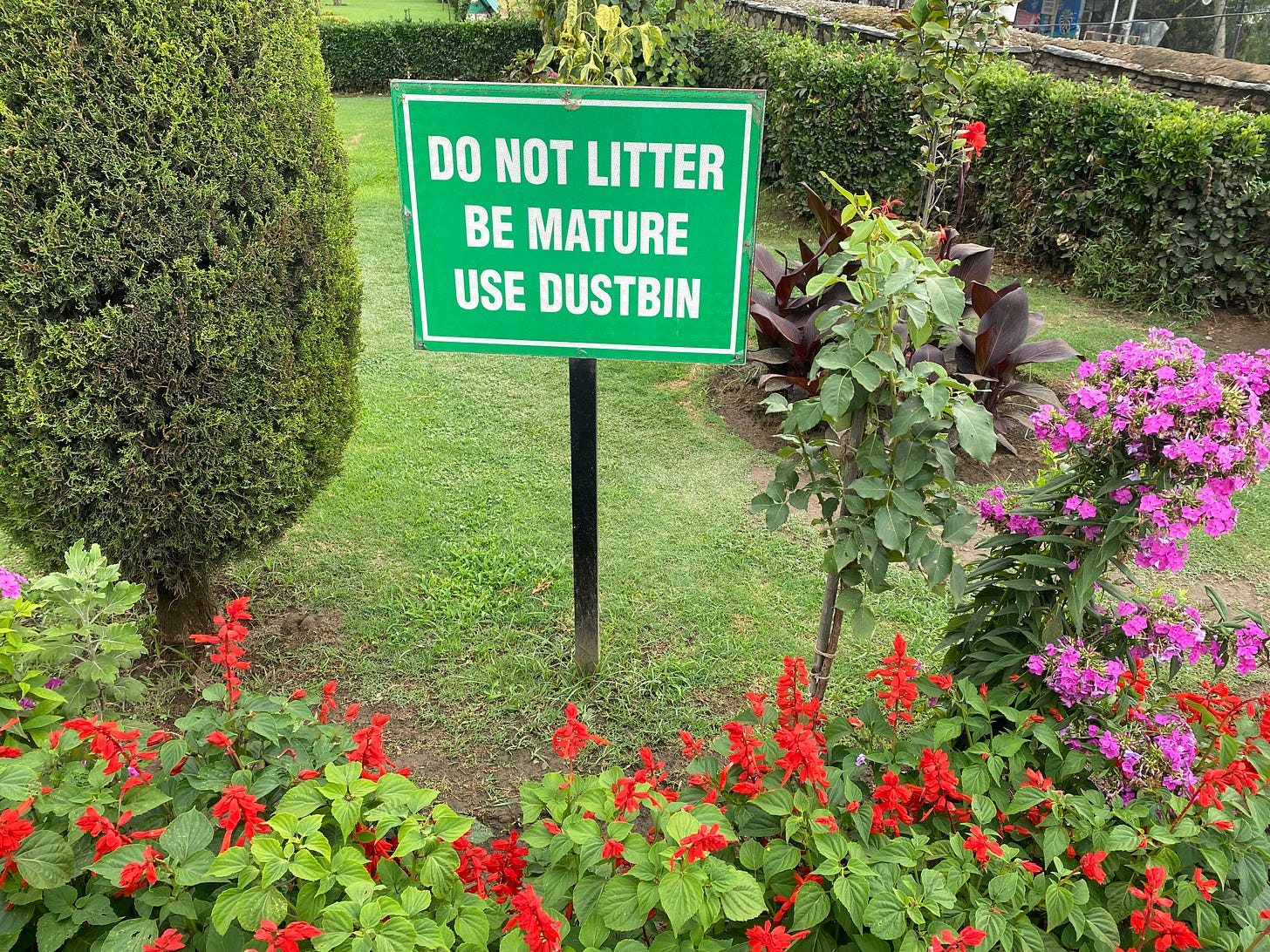Dear Global Jigsaw,
Srinagar is a city of gardens and gunmen. Indian army personnel casually toting large weapons are as much part of the furniture as the chinar (poplar) trees that punctuate its pleasure gardens. If Japanese gardens are all weeping willows and twisting pines, Srinagar’s Mughal gardens are patterned on their Persian Paradise forebears. Euclid would have approved their geometry: flower-bordered terraces aligning a central water channel, evenly spaced with tinkling fountains. Lao Tzu would have given the feng shui a thumbs up: mountain slopes provide a natural frame to their back and the Dal lake stretches out in front.
We spent our first day in the city, garden-hopping between Nishat Bagh, Shalimar Bagh and Pari Mahal. They were so lovely that it was difficult to resist running around the trees with Julio. Instead, we held hands and gazed at each other with more affection than 24 years of domestic debate usually portends.
We looked at the unheeded signposts that rather sweetly asked gardengoers to “Be Mature, Use Dustbin.” Srinagar, for all its peripheral distinctiveness, was core Indian in its littering ways. Carefully manicured lawns were topped off with the shredded remains of entrance tickets, and grease-stained paper napkins.
Several of the water channels had been repurposed into swimming pools for fully clothed adults and stripped-down children. Elsewhere, rows of local outfits were laid out, available for hire to take photos in. Not being chary of cultural appropriation, I dived into something straight out of Kashmir ki Kali and harangued my son into the act as well. His Indo-Spanish genes meant he very much looked the part.
The most magical moment was when we spotted a family of jackals towards the very back of Shalimar Bagh: the pups playing, the noses of the adults quivering, alert for the slightest sign of threat. We kept our distance and watched, filled with the kind of awe that only chancing upon something wild evokes.
Back at our hotel, we spent an afternoon chatting with the owner, Yaser, a fashion designer and seventh generation descendant of a family in the business of pashmina shawls. He told us of his return to the Kashmir Valley a few years ago, after having spent the bulk of his adult years away in Delhi.
In the 1990s, most young Kashmiris who could left for other parts of India. To stay in the valley was to be resigned to a fate where you were either a militant or suspected of being one. (I recommend reading Basharat Peer’s excellent Curfewed Night for a deeply personal exploration of the time). But even those who dispersed to Delhi, Mumbai and other metropolitan centers to work and study could not shake a feeling of unbelonging. They were seen as Indian definitely, because Kashmir was an inalienable part of India, but of the reluctant, rebellious variety. Potentially treacherous or traitorous, or both.
“Who do Kashmiris support in an India-Pakistan cricket match?” my son, Ishaan, asked Yaser. An unvarnished question, but one the answer to which is disproportionately weighty in this cricket-mad part of the world, with its unhealed post partition stress disorder. Our host winced almost imperceptibly. Then he shrugged and answered softly, “Most of the people, probably Pakistan.”
“I just love the textiles in the lobby,” I babbled trying to paper over the awkwardness with words.
Most Kashmiris tend to feel like a crab’s meal, squeezed between the pincers of India and Pakistan. It’s not a choice they care for, but independence is off the table. And so, they are a people without a nation, or more accurately, a people with two unwanted ones.
Yaser explained that through all the years that he spent in India’s capital, he’d had a constant longing to be back home. Srinagar was the water to his inner fish. He finally returned in 2019, determined to start a hotel, since regional tourism had been making a comeback. Two months later, the Modi-led government revoked the state’s autonomous status, flooded the valley with thousands of additional army personnel and cut off the Internet, all in a bid to quell protest against the move. Tourism came to a screeching standstill. Then a year on, the COVID pandemic hit.
When Yaser speaks, a rueful smile is a seemingly permanent facial accompaniment. However, it is now 2024 and Nadis is fully booked out for a 50th birthday party. Speaking of a party, I asked if we could have a beer? Rueful smile unwavering, Yaser informed us that hotels in Kashmir did not serve alcohol.
That evening we discovered that the birthday revelers were in fact angels, having carried a well-stocked bar and accompanying mixologist all the way from Delhi upon their party-bound wings.
It only took a little sniffing around the edges of the carousing with please-give-us-drinks smiles, to be ushered into the celebrations and offered a choice of champagne or specialty cocktails. The evening ended with us shuffling along with assorted family members of the birthday girl to Dancing Queen.
We went to bed a wee bit too late for comfort. Because the real adventure was to begin the next day: a road trip up through some of the world’s highest motorable passes, into the remote region of Dras on the India-Pakistan border. In India, the area conjures up images of a war the two countries fought in 1999. But we’d be on the trail of the Himalayan Brown Bear, an endangered species that roams the region blissfully unaware of anything called “the line of control.”
More on that next week.
xxx
Hope you enjoyed this second part of our Kashmir-Ladakh travelogue. Please share, comment, and if possible, pay for a subscription - either as a present to your well-deserving self, or for a friend who enjoys learning about this endlessly engaging world of ours.
Below (for paid subscribers only) a “to do in Srinagar” listicle of places to shop and eat.





